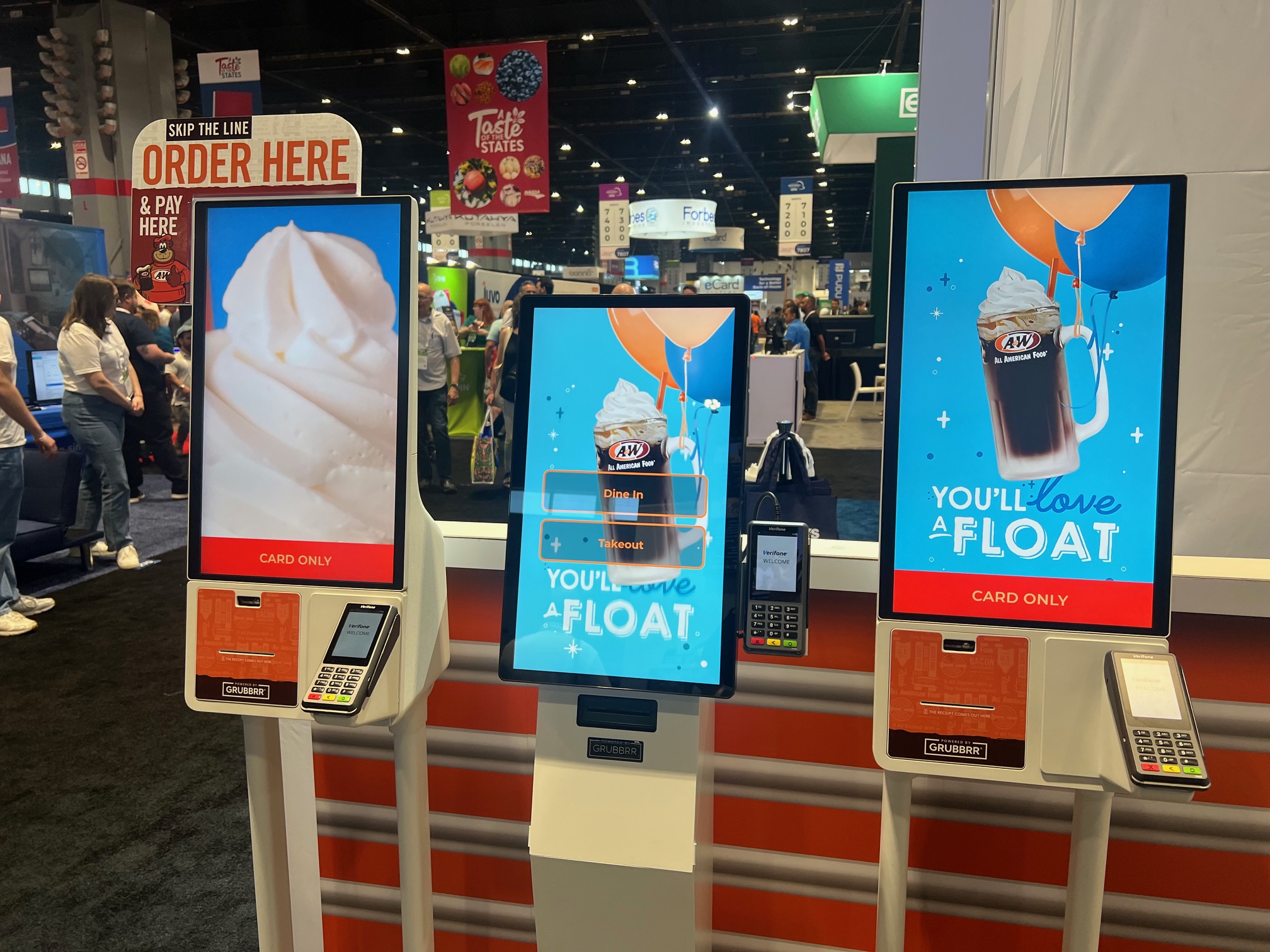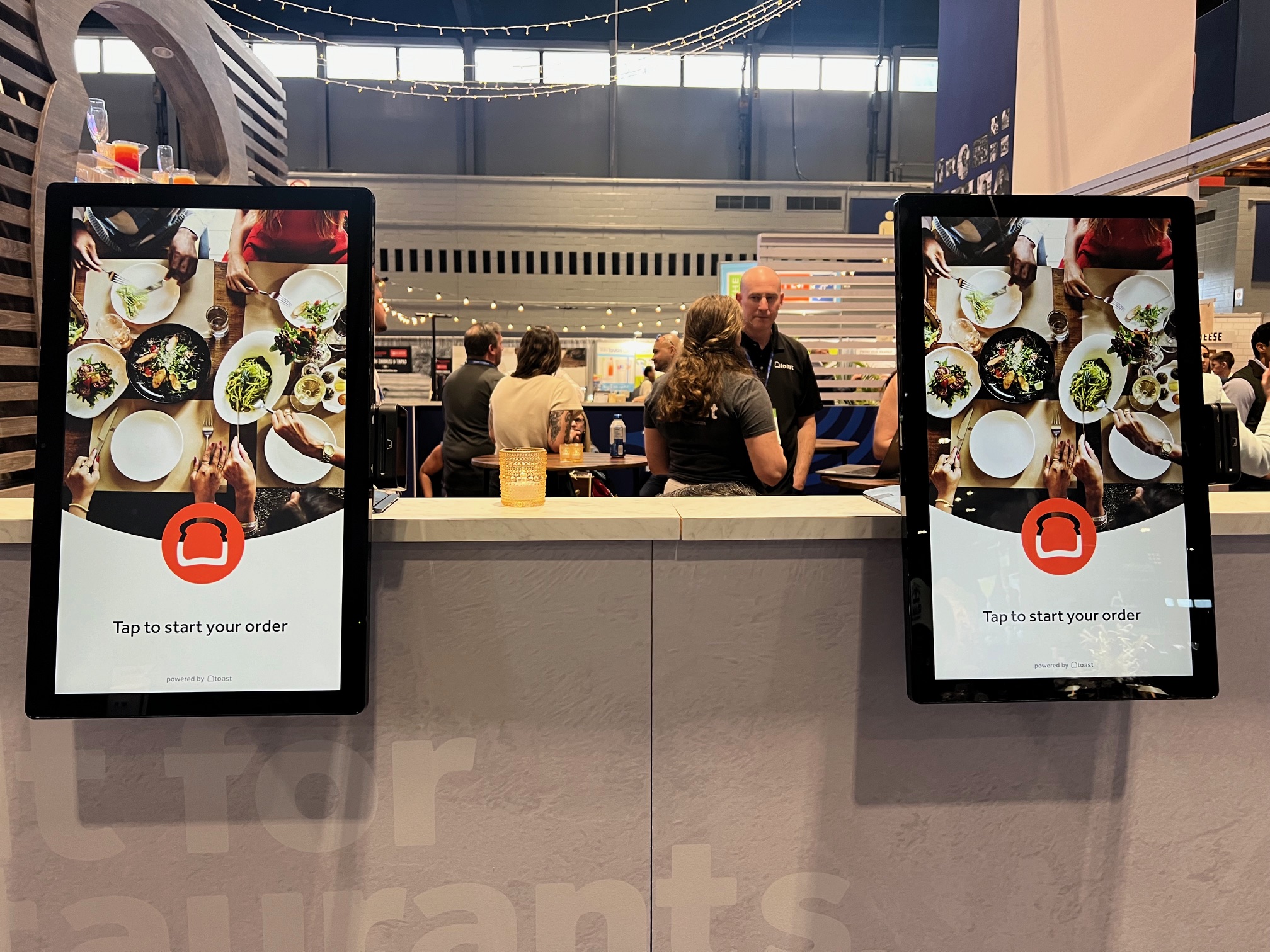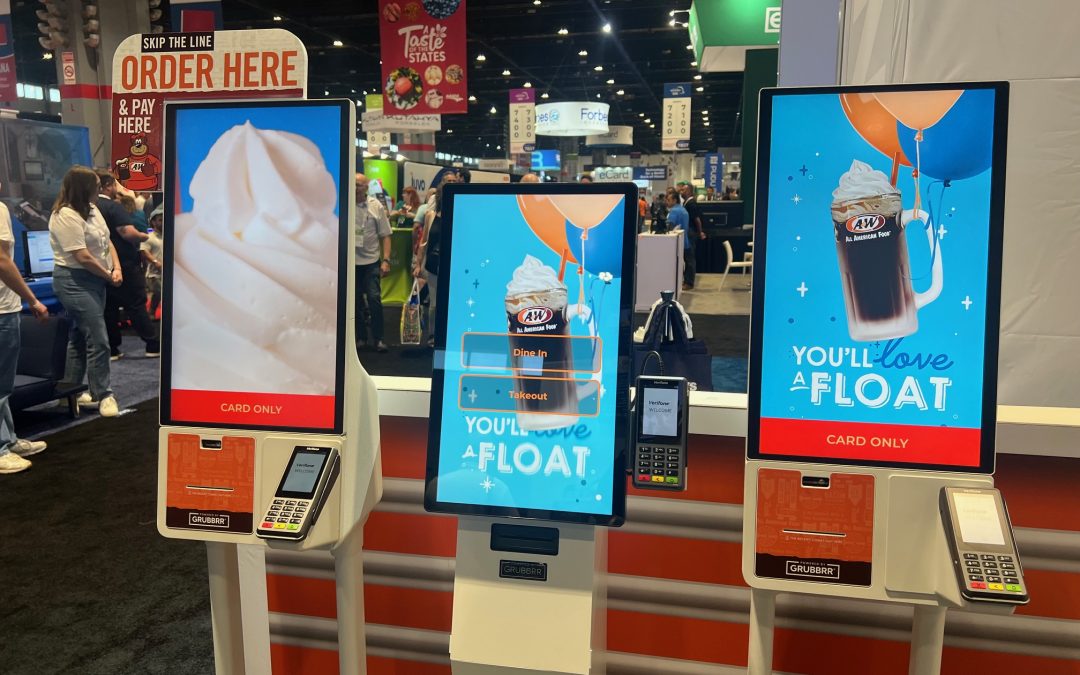California’s new $20 minimum wage for fast food workers is spurring the adoption of restaurant automation tools, from kiosks to drive-thru voice bots.
Kiosks are especially having a moment in the state as quick-service chains look for ways to increase revenue and decrease labor costs.
“Demand from the operators is off the charts,” said Sam Zietz, CEO of kiosk provider GRUBBRR.
In April, fast food workers in California received a 25 percent pay bump. When that happened, Zietz said kiosks went from “nice to have to need to have real, real fast.”

GRUBBRR kiosks displayed at the National Restaurant Association Show in Chicago.
“Kiosks are one of the hottest topics right now,” Mike Whatley, vice president of state affairs and grassroots advocacy at the National Restaurant Association, said during the organization’s 2024 food show last month.
Brandon Barton of kiosk provider Bite said his company is in “active conversations with every major brand in California.”
“If you’re California heavy, and you’re not thinking about automation, your profit margin is going to go away,” he added.
Demand for voice AI products in California is also on the rise, said Gee Lefevre, interim CEO of Presto. The company’s Presto Voice technology can be found at select Carl’s Jr., Hardee’s, Checkers, and Taco John’s restaurants.
“That’s where we’ve seen a huge amount of demand because there is a commercial imperative to make it work,” Lefevre said of the interest in voice AI from California operators.
According to the National Restaurant Association, 51 percent of operators are investing in technologies that make the service area more productive such as kiosks. And that investment is on the rise, increasing to 55 percent in 2024.
As such, POS players like Square are getting into the kiosk game. The company recently debuted Square Kiosk, a fully integrated self-serve ordering solution for quick-service restaurants.
Ming-Tai Huh, head of food and beverage at Square, said the main reason why merchants are demanding kiosks is to better manage “labor costs.”
Barton welcomes the competition.
“It’s nice to see the point-of-sale companies getting into the game as well,” he said. “That just means it is a validation that we are doing something that is valuable to the industry.”
California operators are making drastic changes
While demand for kiosks is growing nationwide, food-tech companies interviewed by Food on Demand report that the highest demand is coming from California.
In response to the $20 minimum wage increase, brands and franchisees with multiple locations in California have raised menu prices, cut labor, and reduced store hours. Some brands are shutting down stores or cautious about expanding to California.
Rubio’s Coastal Grill, a legendary fast-casual fish taco chain from San Diego, filed for Chapter 11 bankruptcy protection in early June after closing 48 stores in California. The company cited the “current business climate” in California as the reason for shuttering the underperforming stores.
Blake Kaplan, a managing director at JLL, said many successful brands from the East Coast and the Midwest are leery of expanding in California.
“Some brands are going to say, ‘Look, my labor is just too high. I can’t be in California,’” he told Food on Demand.
Traffic slips as consumers face menu sticker shock
Ongoing menu increases are also hurting brands operating in California.
Chipotle, Chick-fil-A, Wendy’s, Shake Shack and Starbucks have all raised menu prices to offset costs tied to the state’s new $20 wage law.
Chipotle, for example, said wages went up nearly 20 percent in California when the fast food law went into effect. To offset labor costs, the chain raised menu prices in the state by 6 percent to 7 percent, Jack Hartung, chief financial officer, said during the company’s first quarter earnings call in late April.
These price hikes are causing sticker shock among diners.
Many are retreating, as evidenced by declining traffic reported by brands such as Starbucks, McDonald’s, and Shake Shack.
“There’s only so much price that the restaurants can take before consumers stop coming,” Barton said. “You have to think about innovative ways to change your business model to make the same amount of profit, right? I don’t think anybody’s going to be okay with making less money than they did last year or the year before.”
Kiosks save on labor costs but also boost revenue
One common myth about automation is that it replaces human workers entirely in restaurants. While this is true for some kitchen robotics systems like Miso Robotics’ Flippy and Sweetgreen’s Infinite Kitchen, which replace fry cooks and food assembly positions, kiosk providers maintain that self-serve ordering allows restaurants to redeploy, not replace, labor.
For example, Barton said an employee normally assigned to cashier duties can be freed up to perform more high-value tasks that can’t be automated, such as clearing tables or filling drink orders.
This more efficient use of employees leads to a natural reduction in labor hours for restaurants.

Toast kiosks displayed at the National Restaurant Association Show in Chicago.
Such redeployment is “a big, big lift off the restaurant, from a profit perspective,” said Barton, whose company works with brands such as Taco John’s, Bluestone Lane, and California Fish Grill.
In addition to saving on labor costs, kiosks also boost revenue by efficiently handling every guest order, Barton said.
“If there’s a line of 10 people and it’s just the cashier sitting there, guests may choose to go to the restaurant next door. But if you have multiple kiosks, there are multiple ways to capture the order and take the order,” he said.
Plus, unlike humans, kiosks are programmed to always upsell.
Bite, which raised $9 million in a Series A funding round announced in April, said brand partners see overall check averages increase by about 20 percent. GRUBBRR clients typically see a 12 percent to 20 percent lift in average ticket size, Zietz said.
Consumers prefer self-serve ordering
According to Square’s annual Future of Commerce report, a majority of consumers want restaurants to use AI-based tools with 78 percent preferring to place their orders via self-serve kiosks.
Zietz said consumers like kiosks because it gives them freedom of choice. This drives revenue since kiosks display the restaurant’s entire menu, unlike menu boards that often lack space to list all available items.
“What people don’t realize is we’re actually dramatically improving the consumer experience,” Zietz said. “You’re not being rushed. You’re being presented with options and you’re selecting whatever it is you want.”
By giving people the opportunity to explore a restaurant’s entire menu, consumers tend to order more food.
That’s been the case at Dave’s Hot Chicken.
Jim Bitticks, president and chief operating officer of Dave’s Hot Chicken, said during the 2024 Food on Demand conference that kiosks are not necessarily saving the chain money on labor.
Instead, it’s allowed the fast-growing Nashville-style hot chicken chain to increase sales.
“What’s happening is people are ordering more food on the kiosks,” he said, noting that check averages are about 5 percent to 8 percent more on the kiosks.
Zietz, speaking to Food on Demand during the NRA food show, stated that as more states consider legislation to increase wages for fast food workers, the demand for kiosks will continue to grow. “California is just the tip of the iceberg,” he said.
Eventually, Barton said he hopes the kiosk conversation will shift from which brands are deploying kiosks to highlighting the brands offering the best experiences.
At Bite, the company aims to elevate kiosks by embedding videos and interactive maps on digital kiosk screens, allowing consumers to learn more about menu items or where a brand sources their food. “Real experiential stuff,” Barton said.
Nancy Luna is a contributing writer for Food on Demand. She can be reached at [email protected]


